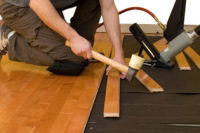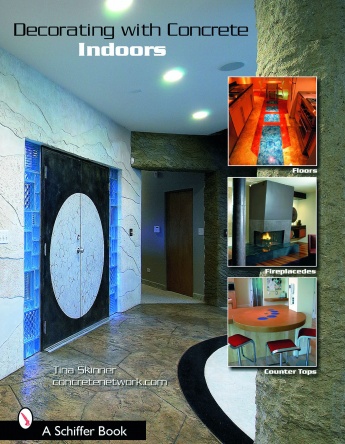
Six degrees of resilient
trouble. There are many things that can compromise the look and performance of
resilient flooring, including (beginning clockwise from upper left): trowel
irregularity show through, adhesive applied with a paint roller; indentations
left by a hospital bed, indentations in a troweled adhesive line, show through
from spray adhesive and indentation in trowel adhesive line.
It is amazing how many times I go to look at the flooring in a hospital and hear the same question: Why are there so many wheel marks and indentations? Typically the flooring material is relatively smooth and multiple coats of high gloss polish have been applied. You talk to the hospital staff and they have no idea that this high gloss finish accentuates even the slightest irregularity in the adhesive, substrate or, of course, the flooring itself. Their only emphasis is on keeping the floor shiny. At almost any hospital is a huge amount of low level light, which only exacerbates the issue.
One reason is that end users and people selecting the flooring can get hung up on features like the static load capability of the material. Their mentality is the higher the number the better the material. They do not take into account issues like the effect foot traffic, stationary equipment and rolling loads might have.
All resilient flooring material indents. The question is to what degree. The industry standard is that an indentation up to 0.005” is acceptable. The trouble is, even an indentation that microscopic is clearly visible on a high-gloss floor in a low level light environment. Also: Where is the indentation actually taking place? Is it in the material, the adhesive or the substrate? What is causing the indentation: heavy equipment, hospital beds, static or dynamic loads, or foot traffic? Let’s look at each of these items to see how they affect the performance of the materials:
High Gloss Finishes.It is hard to say how high-gloss mirror like flooring got its start, but I have seen floors with up to 15 coats of a high-gloss polish buffed to a mirror-like finish. One floor I recall had such a thick build up of polish that the hospital staff was complaining about chairs indenting the material. After a strong floor stripper was employed to remove all that polish, it became clear that the indentations were in the floor finish-not the material. Also when the high-gloss polish came off, we could see that the surface of the material now had a reduced gloss level. Maintenance personnel need to understand that two or three thin coats are better than one heavy coat of polish. Luckily, the management at many hospital chains is realizing that indentations can often be eliminated with a lower gloss polish system.
Materials.It takes a lot to indent a piece of homogeneous or heterogeneous flooring material. When a piece of material is tested for static load capability, it rarely fails to pass the testing. That’s because the indentation is not occurring in the material. It’s in the adhesive or the substrate. Also, while a 0.001” indentation is not very noticeable, an indentation close to the 0.005” maximum can look like a crater in some circumstances (see below ).
Adhesives.This is where most of the indentations occur. In a fine-notch trowel application the adhesive film is about 1/32” deep when applied. After it is allowed to dry-to-touch, the material is put in place and set with a 100 pound roller. Afterward, the remaining adhesive film is, depending upon adhesive, still around 0.018” to 0.022”. That means that an indentation appearing in the adhesive line is very likely, especially if the adhesive is not cured. Finding an adhesive that addresses this can be difficult. If an adhesive is too hard, the installer must be very careful. Any trowel notch or other irregularities in the adhesive spread will show through the finished material. If the adhesive is too soft the possibility of indentation is severe.
Moisture Problems.Marginal moisture conditions are also a concern. For example, if installation starts when the moisture is on the upper limit of what’s acceptable, the adhesive will remain soft and not totally cured (for how long remains to be seen). Soft adhesive film and indentations go together.
Hospital Beds.I have concluded that the manufacturers of hospital equipment have no concern for us in the flooring industry. The casters on some hospital beds are rounded instead of flat and leave a very small foot print (static load pattern). Add the weight of the bed with a patient in it and the load placed on that tiny foot print becomes enormous. When someone attempts to pivot the caster when it is locked in place the possibility of an indentation is extreme.
High Heels.I have also concluded that the manufacturers of women’s shoes have no concern for us either. Stiletto heels are probably the most destructive thing to all types of flooring. These pointed heels create unbelievable force to the surface of the flooring. For instance a 100 pound woman wearing stiletto heels creates about a ton of a pressure-and that’s assuming there is a cap on the heel.
The best way to deal with the problems of indentations on a commercial floor is to carefully control the amount of adhesive applied to the substrate. Also, stress the need for a polish that is a low-gloss or matte finish. The hospital bed problem will remain with us until we get some cooperation from the bed manufacturers. Epoxies are not the answer.






